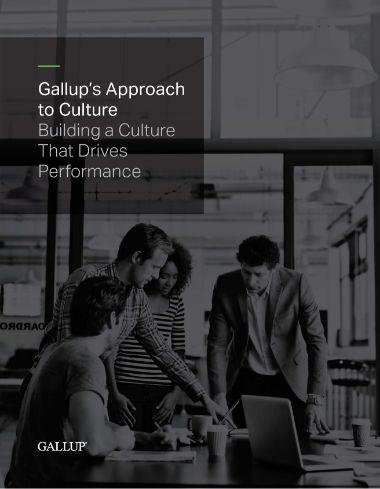Story Highlights
- Culture is constantly shifting, but there are practical ways to define it
- It’s up to executives to envision and track their workplace’s ideal culture
- A successful culture is possible when aligned at five key levels
Work culture often challenges business leaders, and understandably so -- culture is constantly shifting based on internal and external influences, making it tough to define.
Culture can seem elusive because it’s rooted in patterns of thoughts, feelings and behaviors -- in the abstract, not the concrete. Further, culture comes to life in subtle ways -- through shared social norms, beliefs and practices. It’s this intangible (often unspoken) nature of culture that can make it difficult to measure and manage.
As a result, many leaders assume that shaping or influencing culture is HR’s responsibility -- or worse, turn a blind eye to culture despite knowing that culture matters. It matters to employees and customers alike, affecting outcomes for organizations every day. Building a world-class culture requires executive commitment, alignment and involvement.
Gallup’s research shows that employees’ understanding of their company’s purpose and culture is directly linked to measures of business health. Among U.S. employees, roughly four in 10 strongly agree that the mission or purpose of their company makes them feel their job is important. By moving that ratio to eight in 10 employees, organizations could realize a:
- 41% reduction in absenteeism
- 50% drop in patient safety incidents
- 33% improvement in quality
In Gallup’s experience, the best leaders are aware of, in sync with, and actively involved in defining, modeling and coaching their culture and values. For example, one of the leaders of a large government organization keeps a description of his organization’s culture in the front of his notebook to remind him every day of the culture he is trying to create. When leaders are intentional and dedicated, they can build cultures that are unique, change-ready, resilient and high performing.
Fortunately, culture only appears enigmatic: There are practical, tangible, measurable ways leaders can properly manage their culture. And it all starts with alignment. Executives need to be on the same page with their leadership teams -- particularly CHROs -- about where their culture stands today and where it’s headed in the future.
You might be thinking: “We’re already aligned about our culture.” But it’s not enough to be generally on the same page. The best leaders are synchronized on specific, seemingly small details about their culture and how they affect performance. In one of our client organizations, the goal of being a high-performance culture is behind all decisions. Every leadership meeting keeps high performance front and center in their conversation.
For instance, leaders might be on the same page about the core values and beliefs -- such as customer-centricity or excellence in safety outcomes -- that they want their culture to embody. But the best path to excellence varies tremendously by industry, market segment, product and more. How will your workplace be customer-centric in a way that differentiates it from other workplaces? Once that question is answered, leadership should be clear, consistent and committed to the core values. Bear in mind that vague, pedestrian culture aspirations will produce mediocre results at best.
Gallup’s experience suggests that exceptional cultures have intense focus: They’re tailored to the workplace’s customers, mission and value proposition. These best-in-class cultures match the organization’s unique purpose, which makes them memorable and compelling among every key stakeholder group. In pursuit of being the most customer-centric organization in their industry, one of our client CEOs puts the culture conversation at the center of key leadership meetings and connects it back to customer NPS.
It’s up to executives to envision their workplace’s one-of-a-kind ideal culture -- and make it a reality as a unified team, in partnership with HR.
Obsessive Alignment Produces Results
When leaders are aligned on granular details, they build clarity and accountability for their culture -- in everything from resource allocation to their plan for modeling brand behaviors.
In turn, employees learn exactly what differentiates their work culture and how they’re expected to deliver brand promises in every customer interaction.
To get there, leaders should strengthen alignment at five key levels.
Level 1: What Does Culture Mean?
There are many definitions of work culture, and leaders need to have a shared understanding of what culture is and why it matters. Gallup believes that culture is about “how we do things around here” -- the unique way your people live out your company’s purpose and deliver brand promises.
Every workplace should have a special work culture that is true to its history, values and goals. And it’s up to leaders to convene about what culture means to their organization.
Leaders should ask themselves:
- Why does our workplace exist?
- What unique identity do we have?
- How do we make our most important decisions?
Level 2: Why Does Culture Matter?
The best leaders aren’t interested in culture for culture’s sake: Your goal should be to build a culture that drives performance goals. What’s the return on your investment?
Every workplace should have a special work culture that is true to its history, values and goals. And it’s up to leaders to convene about what culture means to their organization.
Gallup’s decades of research shows that a strong culture is a powerful differentiator in the marketplace. A great culture attracts customers, retains them and turns them into brand advocates -- and attracts and engages high-performing employees.
In fact, culture supports safety, innovation, diversity and inclusion, compliance, and more.
Leaders should be categorically clear about the benefits of culture that matter most for their workplace. What goals do you want to use culture to achieve?
Leaders should ask themselves:
- How exactly does our culture enable our strategy today?
- How does our ideal culture influence employees to do what’s best for customers?
- What data do we have to show that our culture helps us achieve customer outcomes?
- How much time and money are we willing to commit to achieve the desired culture?
Level 3: Where Are We Now?
In nearly every organization, a gap exists between leaders’ existing and aspired culture. To close this gap, leaders need to objectively measure their current state. The right metrics will reveal areas of alignment and misalignment between leaders’ vision and what employees actually experience. The goal is not to fit into some sort of predefined culture box -- the goal is to use real, on-the-ground narratives to understand the true story of your organization’s culture.
By establishing a starting point, leaders can craft an effective, tailored roadmap to progress.
Gallup has partnered with organizations of every size and industry to monitor and assess their culture using standardized and customized metrics that are scientifically validated and predictive of outcomes that matter.
Leaders should ask themselves:
- How clear and aligned are our purpose and brand to employees and customers?
- Is our culture consistent across all business units?
- How clearly is the culture cascading down to every employee?
Level 4: Where Do We Want to Go?
Next, leaders need to align on their vision for their culture. Consider what elements you want to keep, change or add to your culture.
For example, perhaps your culture currently has a familiar, family-like feel -- and you want to amplify that by encouraging team members to ask one another about their wellbeing. Or maybe you want to evolve norms and expectations about cross-departmental collaboration to strengthen agility and innovation.
As you carefully define your ideal future state, consider every key stakeholder, including job candidates, customers and shareholders. Remember: The best culture is unique to the organization’s purpose, brand and stakeholders. That is, your aspired culture must be self-defined and individualized. If you settle for one-size-fits-all culture goals, you won’t show your customers and employees what’s uniquely valuable about your brand.
Leaders should ask themselves:
- What do we want our culture to be known for?
- What are the core behaviors we expect team members to display?
- How will those core behaviors show up in front of customers?
- What is unique about us today that we would like to keep, add and change?
If you settle for one-size-fits-all culture goals, you won’t show your customers and employees what’s uniquely valuable about your brand.
Level 5: How Will We Track Progress?
Culture change takes time. In Gallup’s experience, organizations that work on changing company culture typically see the strongest gains in three to five years. To promote ongoing progress, leaders need effective monitoring and accountability metrics.
Through consistent tracking, leaders learn which aspects of their culture are working and which need refining. The best leaders use scientifically based measurements that reveal business units lacking a strong connection to your aspired culture -- and those at risk for turnover, low productivity or customer problems.
By analyzing culture metrics alongside other workplace measures like engagement, leaders can recalibrate their approach and verify the return on their investment in culture.
Leaders should ask themselves:
- What data and KPIs are we consistently using to track our culture?
- How do we maintain a consistent focus and stay committed to the culture change process?
- How do we hold our managers and leaders to the highest level of accountability?
Bottom Line
If you asked your executive team what their role is in culture transformation, what kind of response do you anticipate? Unless there is a clear and unified understanding of the need for culture transformation and their role in executing it, any efforts or investment to drive change will likely yield little to no results.
It’s difficult to overstate the importance of executive alignment when it comes to culture. Culture begins and ends with leaders: Only leaders can establish and communicate a vision -- and bring it to life through their behaviors and actions.
Leaders also need to align on their ongoing role in supporting culture transformation: How will you consistently nurture your culture to drive change? How will you hold leaders and managers accountable? How will you promote and market your culture to the world?
There’s no denying that culture is an advanced concept that takes skill to manage well. But the first step for leaders is straightforward: Commit to prioritizing culture together, as a team, for the long term.
Start prioritizing your culture transformation.
- Learn how to build a culture that enhances your brand, improves business results and fulfills your organization's purpose.
- Know the culture trends affecting your workplace with Gallup's organizational culture indicators.
- Learn how Gallup’s consulting expertise can help you create a competitive advantage with your culture.





